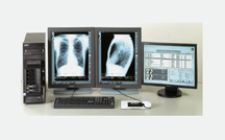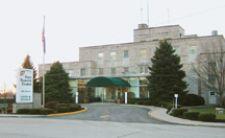
Dunn Memorial Hospital, Bedford, IN
For many rural hospitals, cost-justifying PACS is not just an important consideration – it is a necessity. The Balanced Budget Act of 1997 created the Medical Rural Hospital Flexibility Program in response to a disturbing trend of rural hospital closures. From this Act the Critical Access Hospital (CAH) was created to improve the financial performance of these hospitals. Today, 1,279 certified CAHs are located throughout the U.S.
Since 1904, Dunn Memorial Hospital has served the needs of the rural communities surrounding Bedford, IN, located in the south-central region of the state. For Phyllis Stalker, director of Radiology, taking the next step to an electronic infrastructure was a logical one. “Obviously, PACS is part of the future of radiology. We knew five years ago that we wanted to make this move, but we were waiting for the cost of technology to come down.”
In 2004, Stalker began to seriously research solutions and vendors, yet the cost of PACS was still prohibitive for the facility. Finally, in 2005 it became apparent that the investment cost decreased substantially; however, the final crux was that the film processors in the department required replacement and the cost of film continued to rise substantially. Purchasing new processors as well as continuing to use film would only further strain the radiology department’s budget. For Dunn Memorial, PACS became a reality due to economic necessity.
“At that point in time, we did months of data collection, and ran our numbers to show that our department could recoup the investment in PACS and CR within two years,” Stalker explained. After that point, the department would be fiscally ahead of its current situation with the migration to a near-filmless environment within the facility.
Key Considerations
By the 2005 annual Radiological Society of North America meeting, Stalker had a list of critical considerations as well as preferred vendors. Two factors were most important to her and the facility’s sole radiologist. First, the system must be Web-based; second, the system must have the capabilities to push images to the radiologist during off hours much like a teleradiology solution. Other important, yet less crucial, factors were integration with the facility’s existing RIS and compatibility with a recently-purchased CR system.
Five vendors met the final selection criteria. Stalker and Doug Schwegel, M.D., Dunn Memorial’s radiologist, were most interested in the vendors that offered an ASP model as well.
After all evaluations were completed, Stalker and Dr. Schwegel made the final decision to select BRIT Systems as their PACS vendor. “The key factor was that BRIT has a Linux workstation. Dr. Schwegel liked that platform, and its inherent stability, the best of all the vendors,” Stalker explained.
A Learning Experience
“This system does exactly what we want it to do, although at the time of implementation, I wasn’t quite sure what that was,” Stalker admitted. Described as “beyond a learning experience,” Stalker and her staff changed the department’s entire workflow process. “We re-engineered every aspect of what we do to produce that radiology image. The only thing that has remained the same is the person who greets the patient at the front desk.”
Stalker has been impressed with BRIT’s responsiveness to her department’s changing needs and desire to implement a new electronic workflow built around the advantages of a digital infrastructure. Even BRIT’s integration with Dunn Memorial’s existing RIS was seamless, with reports automatically tied to images.
Today, PACS has created a “whole new learning curve,” Stalker stated, with the senior technologists requesting assistance from the newer technologists who encountered PACS during their schooling. BRIT’s PACS went live first with CR, then the department switched over other modalities one-by-one. “It was a cost-driven decision to go with PACS, further evidenced by the fact I haven’t bought film for almost two months.
“We are currently 95 percent filmless, with that five percent filling the requests of clinicians outside our facility,” Stalker said. A staff member is currently assigned to handle PACS issues that may arise and scan prior film, although she noted this is decreasing weekly. “Although our volume hasn’t increased, we have become more efficient by reducing the number of steps involved in the patient care process.”
Stalker has also implemented a clever marketing program while at the same time reducing costs. “We use CDs to give our patients their images, and on that CD is our hospital logo in a marketing-friendly package that is cost-effective while also reducing the time it takes to produce,” she added.
For this Critical Access Hospital, PACS was a logical and economically-viable choice. According to Stalker, “Our experience shows that a Critical Access Hospital can afford PACS and still save money by migrating from a film-based to a filmless environment.”


